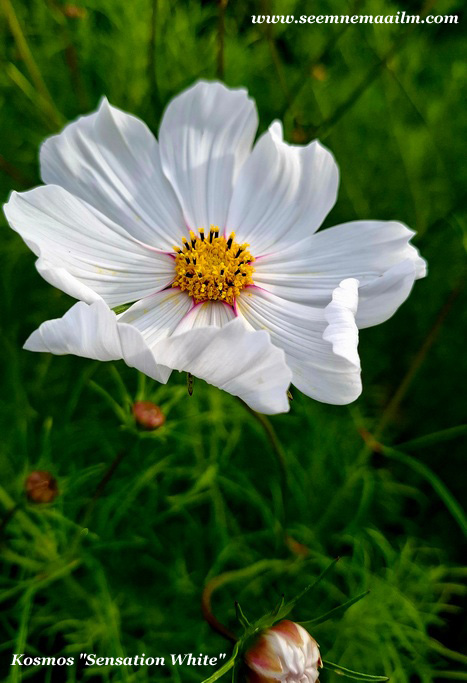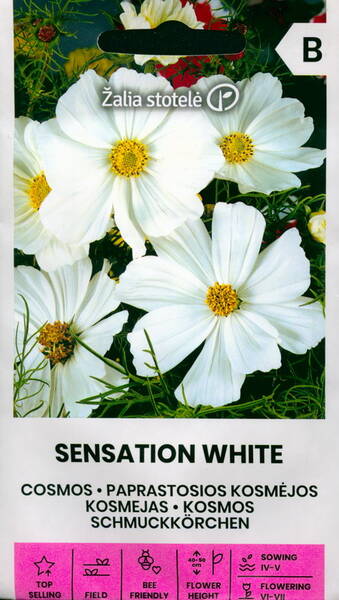An abundance of large flowers!
The plant is up to 50 cm high. The flowers are collected in inflorescences-baskets, 7-10 cm in diameter and are located singly at the ends of the stems. Reed's flowers are white. Tubular in the centre of the inflorescence - yellow.
The leaves are very elegant juicy green and openwork. It is used for planting flower beds in the background, decorating fences and for cutting. With the help of cosmea, you can easily and quickly fill large spaces with a bright flowering carpet.
Agricultural technology.
The plant is light-loving and cold-resistant. It is not demanding on soils but grows best on light, fertile soils. Sowing of seeds is carried out in April-May directly in open ground. 1.0 g = 120-145 seeds.
The seeding depth is 1 cm. At a soil temperature of +18°C, seedlings appear in 8-14 days. Distance between plants 30-35 cm.

Homeland: mountainous regions of Mexico. Herbaceous annual plant. Stems dense, erect, 80-150 cm tall. The leaves are twice pinnately dissected into filamentous lobes, which gives the whole plant an openwork appearance. Inflorescences are large, 7-10 cm in diameter, solitary or collected in a rare corymb. Marginal flowers reed, white, pink, red or purple, tridentate at the top, arranged in one or more rows; tubular - small, yellow, form a small disk. Blooms profusely from mid-June to September. Seeds ripen well and remain viable for 3-5 years. Gives abundant self-seeding. In culture since 1799.
Location: photophilous plants, cold-resistant.
Soil: undemanding to the soil, but grow better on loose and rich in nutrients.
Care: timely and regular watering, withered inflorescences are immediately removed - this stimulates the formation of new buds. Tall varieties are tied to stakes driven into the soil. On nutrient-rich soils, feed every 6-8 weeks, and on poor soils every 3-4 weeks with a solution of complete mineral fertilizer.
Reproduction: seeds. Sowing is done in April in open ground or cold greenhouses. Seedlings are sown from March to mid-April. Only press the seeds into the substrate without sprinkling soil on top, as they need light to germinate. At a temperature of 15-18 degrees shoots appear in 1-2 weeks. Seedlings are planted in a place in May at a distance of 30-35 cm. Transplantation is well tolerated.
Use: recommended for large groups near fences and walls, rarely for cutting.
Partners: combined with variegated letniki, suitable for colours (vervain, Turkish carnation, phlox), also with chamomile, marigolds and dimorphoteca. A good silver-white duet of a two-year-old giant eryngium and a white-flowered cosmos.
Eng.: Tall cosmos, cosmea, garden cosmos. Bot.syn.: Cosmea bipinnata.
* Garden cosmos is one of the most common annual plants decorating flower beds.
True, some gardeners believe that cosmea does not look refined enough - it has too large inflorescences that have too bright, flashy colours ...
However, as a result of targeted breeding work, varieties with small inflorescences and a more modest colour scheme have now appeared, so the plant can be selected for every taste.
Those who like lush, intense flowering have appreciated cosmea for a very long time.
Cosmos is good to plant in the background of the border. The background formed by its finely dissected feathery leaves and numerous inflorescences looks very informal.












